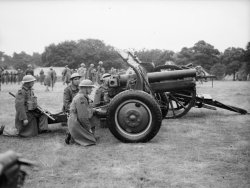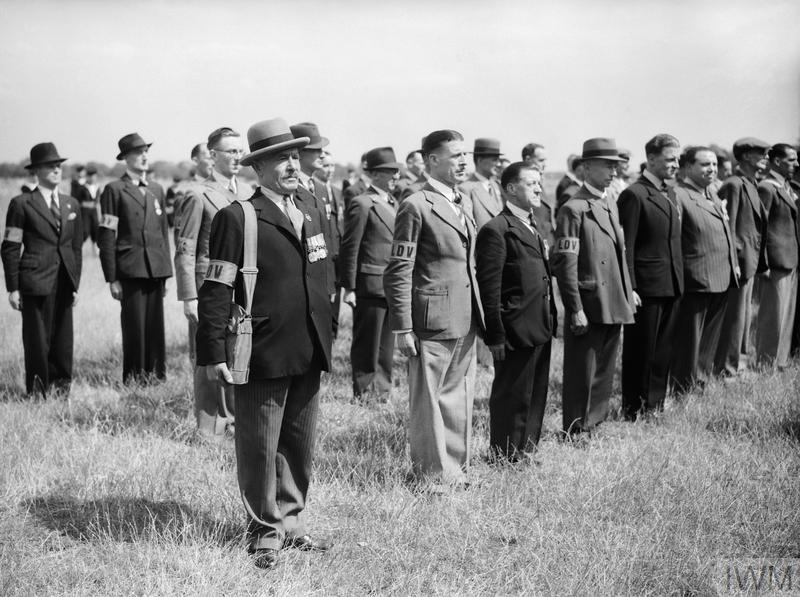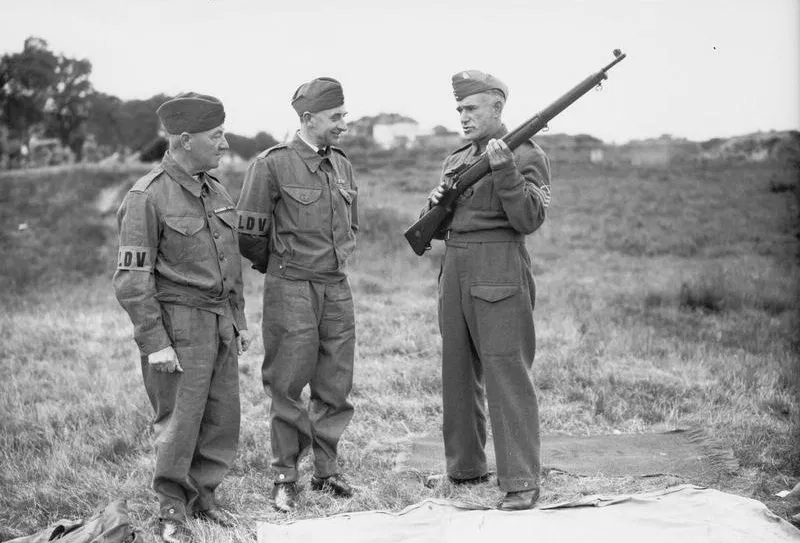
So after Dunkirk, did Britain really stand alone or in a prime strategic position ready to assail any invasion?*
Umm... let's look at the Home Forces and Territorial Army a bit. /1
*Sealion is STILL not viable.
#WW2 #SWW #History

Umm... let's look at the Home Forces and Territorial Army a bit. /1
*Sealion is STILL not viable.
#WW2 #SWW #History


It is really, really, really, REALLY, hard to see the crisis in June/July 1940 through a jolly lens.
Whilst much of the BEF managed to make it back to Britain, they left huge stocks of kit, guns, equipment, uniforms, webbing, ammunition, motor transport and AFVs in France. /2



Whilst much of the BEF managed to make it back to Britain, they left huge stocks of kit, guns, equipment, uniforms, webbing, ammunition, motor transport and AFVs in France. /2




Even before the fall of France, the Army had actually been short of tons of kit - with the situation steadily improving on the continent, less so in Britain.
The photographic record for Home Forces during this period is pretty shit, so there will some memes. You are warned./3
The photographic record for Home Forces during this period is pretty shit, so there will some memes. You are warned./3

Few Territorial Army formations went to France in 1940 as the majority stayed in Britain.
These soldiers from D Company, 4 Welch (yup 53rd Welsh Division) are bloody well equipped for your average Terrier.
No anklets, but BD, SMLEs, and transitional webbing. /4
These soldiers from D Company, 4 Welch (yup 53rd Welsh Division) are bloody well equipped for your average Terrier.
No anklets, but BD, SMLEs, and transitional webbing. /4

So the webbing alone points to something unusual, given it uses modified 37 pouches on 08 webbing!
There were critical shortages of new 37 pattern webbing so most had to make do with threadbare 08, a smattering of transitional 08/37 hybrids, or nothing.
Yup nothing. /5
There were critical shortages of new 37 pattern webbing so most had to make do with threadbare 08, a smattering of transitional 08/37 hybrids, or nothing.
Yup nothing. /5

TA units DID get new battledress, weapons, webbing but BEF demands were so bloody high that stocks were urgently recalled and immediately sent to field forces long before May 1940.
So like many TA units had wooden guns and sigs gear. /6
So like many TA units had wooden guns and sigs gear. /6
Many Home Forces soldiers didn't have uniforms.
Like well into 1940.
So instead we start digging through moth-eaten stocks of service dress, and once this is done issue they dragged out ancient denim workwear, once THIS was exhausted any remnants or civvie gear. /7
Like well into 1940.
So instead we start digging through moth-eaten stocks of service dress, and once this is done issue they dragged out ancient denim workwear, once THIS was exhausted any remnants or civvie gear. /7
We also normally forget that the recall to industry stripped many TA formations of their best NCOs and trained soldiers as the TA had been so massively expanded from 1937.
And like doubled in March 1939.
This was a fucking terrible idea. /8
And like doubled in March 1939.
This was a fucking terrible idea. /8

I'll pop a thread up on the Doubling of the TA in 1939 and the catastrophic results of that well into, umm, yes... 1941 or so, one day.
One day.
With so few competent soldiers, this all meant the essential TA divisions were practically untrained. /9
One day.
With so few competent soldiers, this all meant the essential TA divisions were practically untrained. /9
They also had no proper accommodation, no bunk beds, no trained sanitation specialists, few trained cooks, new technical specialists...
And vehicles were often impressed commercial civvie sorts, usually with the former owner's branding left on for lack of paint.
Yup. /10
And vehicles were often impressed commercial civvie sorts, usually with the former owner's branding left on for lack of paint.
Yup. /10
It should be no surprise that the photographic record for this period is fucking awful, as it was a massive embarrassment and huge int risk.
By June 1940 things had improved-ish on a training front with battalion level initiatives, but the quality is questionable. /11
By June 1940 things had improved-ish on a training front with battalion level initiatives, but the quality is questionable. /11

Here's some wooden guns.
Yup.
Brens, anti-tank guns, signals gear, wireless sets were all mocked up in wood and Terriers roleplayed their profession on training. /12
Yup.
Brens, anti-tank guns, signals gear, wireless sets were all mocked up in wood and Terriers roleplayed their profession on training. /12

Many battalions may have a single Bren Gun Carrier, 18 Pounder or two Pounder to train on. Or rather old, completely shagged out field guns which are basically too dangerous to be used by the BEF. /13 





Lewis guns come back out, even then well short of requirements and are often hated.
Now quite how this popular, reliable weapon from the Great War ended up quite so reviled should be obvious... these 'new' weapons were yet more completely bollocksed, worn out examples. /14
Now quite how this popular, reliable weapon from the Great War ended up quite so reviled should be obvious... these 'new' weapons were yet more completely bollocksed, worn out examples. /14

Anti-tank provision was dire and even when Brigade Anti-Tank Companies were formed, many never received their proposed Hotchkiss 25mm anti-tank guns, instead taking delivery of vehicles like the Bedford OXA 'Ironside'.
But this is a tale for another day... /15


But this is a tale for another day... /15



To be blunt.
By June 1940, the Army had only really just barely managed to build enough bunk beds and finally secure only half-rotten/dilapidated accommodation for Home Forces' Territorial Army Divisions, essential for defence. /16
By June 1940, the Army had only really just barely managed to build enough bunk beds and finally secure only half-rotten/dilapidated accommodation for Home Forces' Territorial Army Divisions, essential for defence. /16
That said the time of civvie attired clothing had been stamped on, but many new recruits would suffer similar indignities.
So when we laugh about the LDV aesthetic, remember MANY Territorial Army battalions resembled this in early 1940. /17



So when we laugh about the LDV aesthetic, remember MANY Territorial Army battalions resembled this in early 1940. /17




Some battalions didn't receiving their full issue of BD until around March 1941.
Personnel were also poorly employed, thrown wherever. Formation of Independent Companies for the Norwegian campaign sapped many of the fittest, motivated and brightest for fledgling SF. /18


Personnel were also poorly employed, thrown wherever. Formation of Independent Companies for the Norwegian campaign sapped many of the fittest, motivated and brightest for fledgling SF. /18



Much of these problems stemmed from pre-war admin decisions of all things. A TA Division's peace time Divisional HQ was a small fraction of what was required in war, and to save cash much admin was passed onto Territorial Army Associations.
Regional mergers saved more £££. /19
Regional mergers saved more £££. /19
So when was was declared the TA didn't really have control over much of their own admin/bureaucratic systems or the staff, which is again, another story for another day.
By 1940 these problems were being engaged with, as staff officers tried to find and comb out specialists. /20
By 1940 these problems were being engaged with, as staff officers tried to find and comb out specialists. /20

This followed a deeply depressing spate of suicides from men simply not suited to the roles or units they were sent to.
The value of much training achieved in this period is pretty questionable, and morale could be pretty poor. /21
The value of much training achieved in this period is pretty questionable, and morale could be pretty poor. /21

That said some soldiers and their families took it on themselves to feed new recruits and make them feel welcome, which did encourage fairly quick integration in such dire environments.*
*Literally living in leaky shacks. /22
*Literally living in leaky shacks. /22
So...
When someone next declares how strong Britain was in 1940, look at Home Forces' formations a bit closer.
You will be really, really surprised by what you'll find.
And how assumption still underpins a lot of #WW2 #History. /thread
When someone next declares how strong Britain was in 1940, look at Home Forces' formations a bit closer.
You will be really, really surprised by what you'll find.
And how assumption still underpins a lot of #WW2 #History. /thread
A side point is it may present an interesting point for considering how this pandemic is remembered.
peeps remember raf spitfires disproportionately in 1940 and study them to an ridiculous extent saying the same sorta things it is quite dull really perhaps we do this again ? ??
peeps remember raf spitfires disproportionately in 1940 and study them to an ridiculous extent saying the same sorta things it is quite dull really perhaps we do this again ? ??

• • •
Missing some Tweet in this thread? You can try to
force a refresh




















